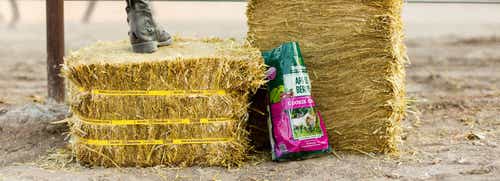
Feeding Goats: What you need to know about forages and winter
Goats are ruminant animals who eat plants and digest them through a four-compartment stomach. They are more like deer regarding nutrition, than they are to sheep or cattle, which eat a lot of grass.
Goats are well-known for their ability to forage on anything from fresh grass to woody shrubs. They are browsers versus grazers (for example, cattle, sheep, and horses are grazing species). For this reason, they are excellent at clearing rough, overgrown land.
Forage is the main source of nutrients for goats apart from their range. It's what they eat in the winter when they don't have access to grazing ground. Forage can be a grass, or a legume such as alfalfa.
Each goat needs about two to four pounds of hay per day (3-4% of body weight in pounds), which can be fed free choice or twice a day.
If good range isn't available, dry grass forage of a horse quality is acceptable. Goats require additional hay, which is roughage, for their rumen to function properly. The long fiber lengths are necessary for this. The rumen is the first stomach compartment (rich in live bacteria) that begins to digest the fiber.
Alfalfa hay is also popular for feeding goats and has more protein, vitamins, and minerals than grass hays, typically. It can be a good choice for feeding milking goats as it has more protein, energy and calcium.
Early to mid-winter is a time when does should be in early pregnancy. Begin increasing the nutritional level of a pregnant doe's diet about six weeks before kidding, so that by the time kidding occurs, she is at the level of nutrition that she needs for lactation. When lactation starts, the protein requirement of a goat more than doubles. Just feeding a grain to help with energy is not enough. Milk formation requires protein. Alfalfa is the only hay with enough protein to meet the needs of a lactating doe. However, the producer must carefully and slowly increase the protein intake of a pregnant doe, gradually adding appropriate feed to her diet as her pregnancy progresses. A sudden change in any type or amount of feed can lead to host of problems.
Apart from nutrition, the other benefits of feeding plenty of good quality forage to goats is it will keep them warm. This is important as goats have thinner skin and do not develop thick coats. A byproduct of bacterial fermentation in the rumen is heat, so feeding your animals plenty of forage will keep them warm from the inside out.
A good rule is to not make drastic changes to the diets of your goats. Slowly introduce new hays or feed to avoid a major digestive upset for them. Change their diets slowly, giving the bacteria in their rumen (their first stomach, which is made for the initial step in the digestion of the plants they eat) time to adjust.








